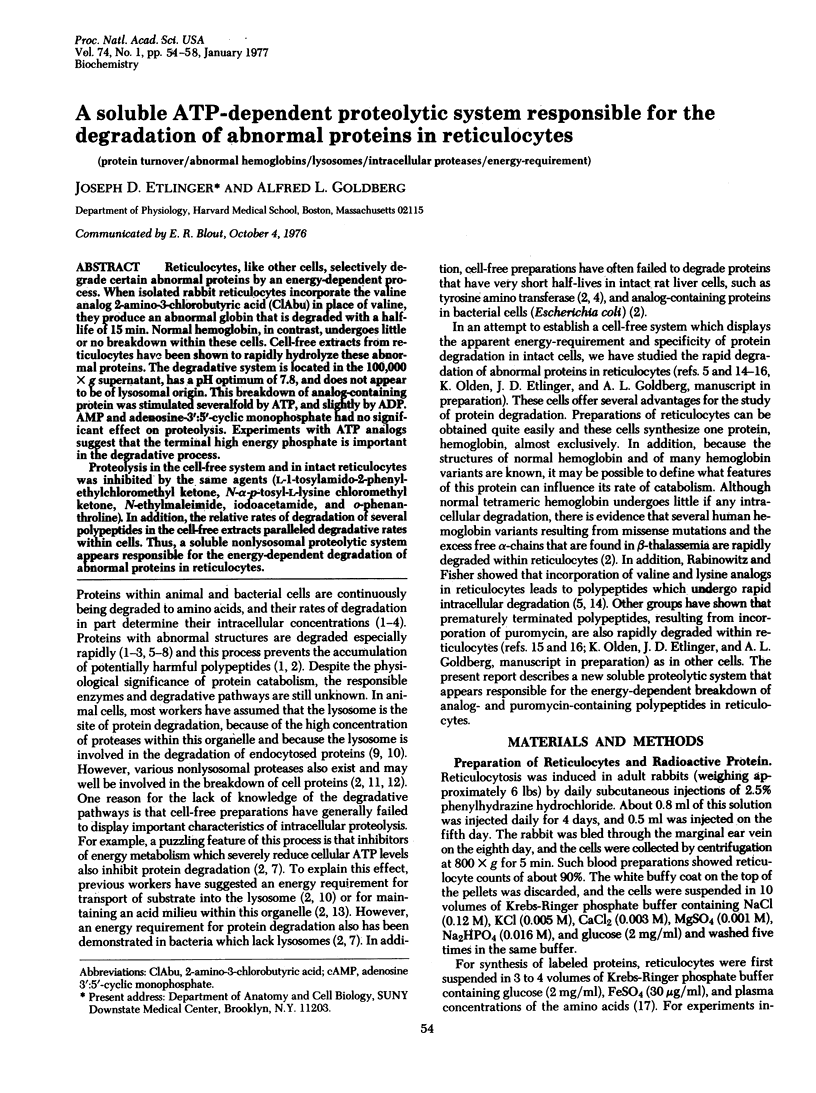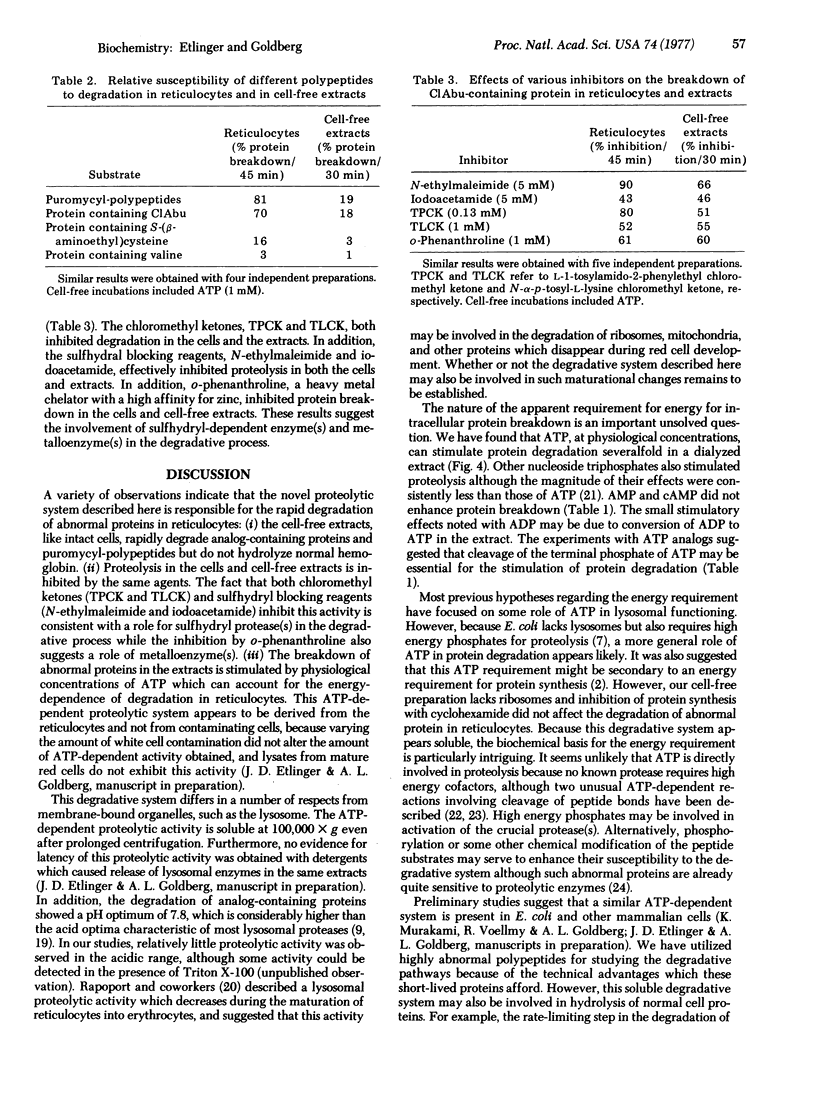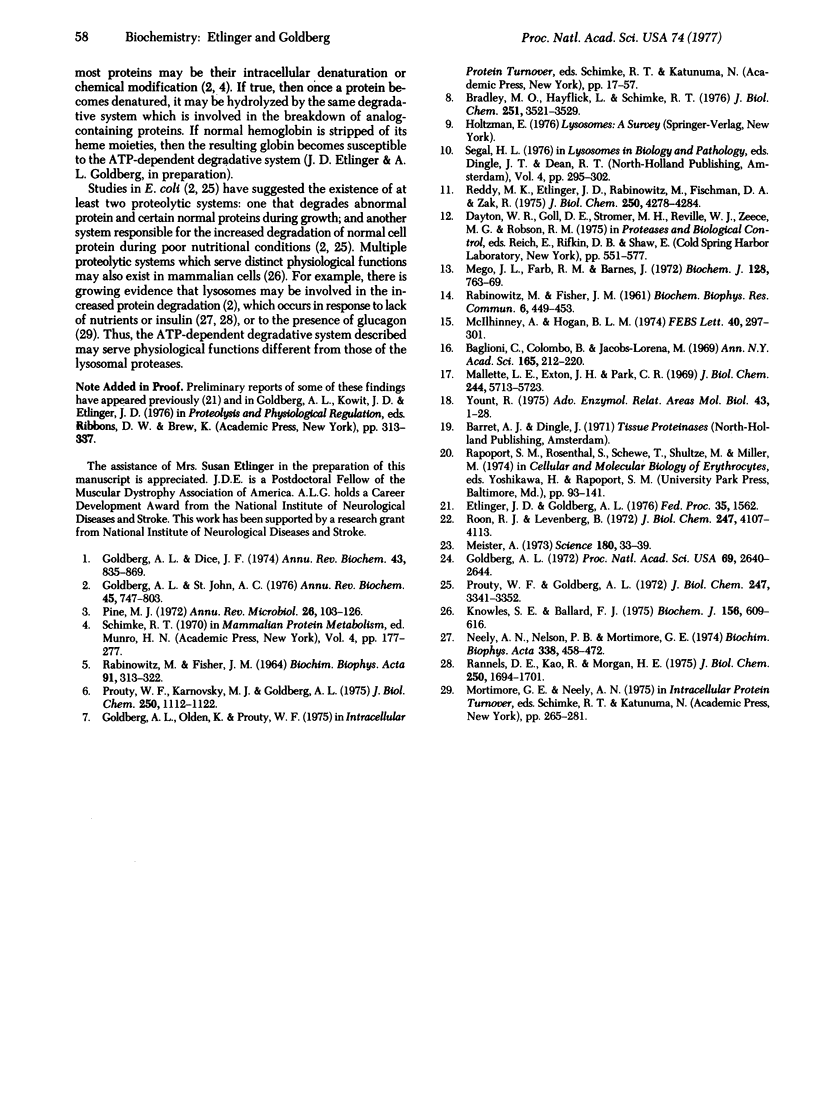Abstract
Reticulocytes, like other cells, selectively degrade certain abnormal proteins by an energy-dependent process. When isolated rabbit reticulocytes incorporate the valine analog 2-amino-3chlorobutyric acid (ClAbu) in place of valine, they produce an abnormal globin that is degraded with a half-life of 15 min. Normal hemoglobin, in contrast, undergoes little or no breakdown within these cells. Cell-free extracts from reticulocytes have been shown to rapidly hydrolyze these abnormal proteins. The degradative system is located in the 100,000 X g supernatant, has a pH optimum of 7.8, and does not appear to be of lysosomal origin. This breakdown of analog-containing protein was stimulated severalfold by ATP, and slightly by ADP. AMP and adenosine-3':5'-cyclic monophosphate had no significant effect on proteolysis. Experiments with ATP analogs suggest that the terminal high energy phosphate is important in the degradative process. Proteolysis in the cell-free system and in intact reticulocytes was inhibited by the same agents (L-l-tosylamido-2-phenyl-ethylchloromethyl ketone, N-alpha-p-tosyl-L-lysine chloromethyl ketone, N-ethylmaleimide, iodoacetamide, and o-phenanthroline). In addition, the relative rates of degradation of several polypeptides in the cell-free extracts paralleled degradatives rates within cells. Thus, a soluble nonlysosomal proteolytic system appears responsible for the energy-dependent degradation of abnormal proteins in reticulocytes.
Full text
PDF




Selected References
These references are in PubMed. This may not be the complete list of references from this article.
- Baglioni C., Colombo B., Jacobs-Lorena M. Chain termination: a test for a possible explanation of thalassemia. Ann N Y Acad Sci. 1969 Nov 20;165(1):212–220. doi: 10.1111/j.1749-6632.1969.tb27791.x. [DOI] [PubMed] [Google Scholar]
- Bradley M. O., Hayflick L., Schimke R. T. Protein degradation in human fibroblasts (WI-38). Effects of aging, viral transformation, and amino acid analogs. J Biol Chem. 1976 Jun 25;251(12):3521–3529. [PubMed] [Google Scholar]
- Goldberg A. L. Correlation between rates of degradation of bacterial proteins in vivo and their sensitivity to proteases. Proc Natl Acad Sci U S A. 1972 Sep;69(9):2640–2644. doi: 10.1073/pnas.69.9.2640. [DOI] [PMC free article] [PubMed] [Google Scholar]
- Goldberg A. L., Dice J. F. Intracellular protein degradation in mammalian and bacterial cells. Annu Rev Biochem. 1974;43(0):835–869. doi: 10.1146/annurev.bi.43.070174.004155. [DOI] [PubMed] [Google Scholar]
- Goldberg A. L., St John A. C. Intracellular protein degradation in mammalian and bacterial cells: Part 2. Annu Rev Biochem. 1976;45:747–803. doi: 10.1146/annurev.bi.45.070176.003531. [DOI] [PubMed] [Google Scholar]
- Knowles S. E., Ballard F. J. Selective control of the degradation of normal and aberrant proteins in Reuber H35 hepatoma cells. Biochem J. 1976 Jun 15;156(3):609–617. doi: 10.1042/bj1560609. [DOI] [PMC free article] [PubMed] [Google Scholar]
- Mallet L. E., Exton J. H., Park C. R. Control of gluconeogenesis from amino acids in the perfused rat liver. J Biol Chem. 1969 Oct 25;244(20):5713–5723. [PubMed] [Google Scholar]
- McIlhinney A., Hogan B. L. Rapid degradation of puromycyl peptides in hepatoma cells and reticulocytes. FEBS Lett. 1974 Apr 1;40(2):297–301. doi: 10.1016/0014-5793(74)80248-6. [DOI] [PubMed] [Google Scholar]
- Mego J. L., Farb R. M., Barnes J. An adenosine triphosphate-dependent stabilization of proteolytic activity in heterolysosomes. Evidence for a proton pump. Biochem J. 1972 Jul;128(4):763–769. doi: 10.1042/bj1280763. [DOI] [PMC free article] [PubMed] [Google Scholar]
- Meister A. On the enzymology of amino acid transport. Science. 1973 Apr 6;180(4081):33–39. doi: 10.1126/science.180.4081.33. [DOI] [PubMed] [Google Scholar]
- Pine M. J. Turnover of intracellular proteins. Annu Rev Microbiol. 1972;26:103–126. doi: 10.1146/annurev.mi.26.100172.000535. [DOI] [PubMed] [Google Scholar]
- Prouty W. F., Goldberg A. L. Effects of protease inhibitors on protein breakdown in Escherichia coli. J Biol Chem. 1972 May 25;247(10):3341–3352. [PubMed] [Google Scholar]
- Prouty W. F., Karnovsky M. J., Goldberg A. L. Degradation of abnormal proteins in Escherichia coli. Formation of protein inclusions in cells exposed to amino acid analogs. J Biol Chem. 1975 Feb 10;250(3):1112–1122. [PubMed] [Google Scholar]
- RABINOVITZ M., FISHER J. M. CHARACTERISTICS OF THE INHIBITION OF HEMOGLOBIN SYNTHESIS IN RABBIT RETICULOCYTES BY THREO-ALPHA-AMINO-BETA-CHLOROBUTYRIC ACID. Biochim Biophys Acta. 1964 Oct 16;91:313–322. doi: 10.1016/0926-6550(64)90255-5. [DOI] [PubMed] [Google Scholar]
- Rannels D. E., Kao R., Morgan H. E. Effect of insulin on protein turnover in heart muscle. J Biol Chem. 1975 Mar 10;250(5):1694–1701. [PubMed] [Google Scholar]
- Reddy M. K., Etlinger J. D., Rabinowitz M., Fischman D. A., Zak R. Removal of Z-lines and alpha-actinin from isolated myofibrils by a calcium-activated neutral protease. J Biol Chem. 1975 Jun 10;250(11):4278–4284. [PubMed] [Google Scholar]
- Roon R. J., Levenberg B. Urea amidolyase. I. Properties of the enzyme from Candida utilis. J Biol Chem. 1972 Jul 10;247(13):4107–4113. [PubMed] [Google Scholar]
- Yount R. G. ATP analogs. Adv Enzymol Relat Areas Mol Biol. 1975;43:1–56. doi: 10.1002/9780470122884.ch1. [DOI] [PubMed] [Google Scholar]


